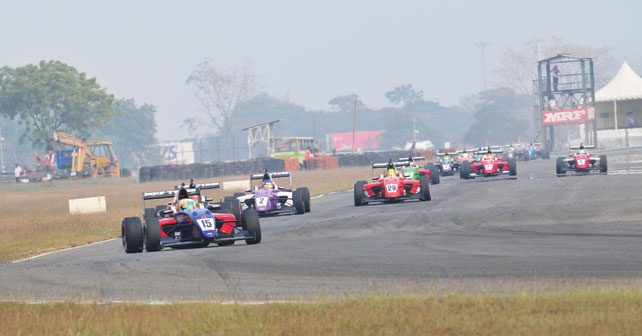The 2015-16 MRF Challenge ended in Chennai, looking a lot like what it had been originally created to be, an attractive winter series for international junior racers.
The MRF F2000 Challenge always seemed like a hard sell for those in India looking for a single seater series with advanced equipment to try out before trying their luck overseas. It’s Rs. 34 lakh budget – expected to rise as a new car is introduced – is out of the reach of most racing drivers from India and those whose families can afford that much generally tend to go straight to Europe anyway.
In its first season when a support round with the Indian Grand Prix was included, there were attempts by Indian drivers to sign up for the series to race alongside the likes of Conor Daly and Jordan King, racing drivers acknowledged to be up and comers on the international scene.
Amid talks of discounted or free drives for the foreign drivers and no concessions for Indian racers, it was only one or two drivers who made it to the grid while others who tried to raise funds said they were given little or no leeway to do so.
Following its inaugural year and a slight dip in the caliber of the drivers on the gird, the 2015-16 edition of the championship was positioned firmly as an alternative to the other winter championship for European based drivers to stay active before their regular racing seasons could start again.
With its announcement that it will be upgrading its car to try and become the ‘Indian Formula 3’, the MRF Challenge is now squarely taking aim at the New Zealand based Toyota Racing Series as a winter series that offers drivers seat time in a car that is as close as possible to the most important junior racing discipline of all..the FIA European Formula 3 Championship.
Two of India’s best hopes of representing the tricolor in Formula 1 – Arjun Maini and Jehan Daruvala – have participated in the TRS with some success over the last two seasons.
The crucial difference between the TRS and the MRF Challenge currently is that the latter manages to race at FIA Grade 1 circuits like Abu Dhabi and Bahrain – which are also F1 venues – and that the TRS features teams that run identical cars throughout the tightly compressed season. The MRF Challenge is centrally controlled, with engineers assigned to each car, although some drivers do seem to get a little more attention than others. This was clear by the near constant presence of engineers around the car of Mick Schumacher, son of F1 legend Michael and one of the latest drivers with a famous last name that MRF used to help increase the series’ profile.
The son of prolific F1 designer Adrian Newey, Harrison, was also driving as was this season’s champion Pietro Fittipaldi, grandson of Emerson. Last season Niki Lauda and James Hunt’s sons were drafted while the year before that Damon Hill’s son – who eventually quit racing all together – was the center of attention too.
Fittipaldi, who had competed in last year’s European F3 championship, had finished the season in 17th place, with no top five finishes to his name and just five points ahead of Maini – who had managed two top fives - in the points standings. This year’s runner up, Tatiana Calderon, had finished her third European F3 season last year and failed to score any points, just like her first season in 2013.
Newey will start his second full season of car racing in European F3 this year, while Schumacher finished his first full season last season. The two were teammates in the ADAC F4 Championship where the German finished 10th with 92 points and Newey was 16th with 42.
Seeing these drivers compete a full season against early tear-away leader Nobuharu Matsushita would have been interesting but the Japanese called it quits after just two rounds. Even more intriguing would have been seeing Daruvala in the mix but maybe his absence, as well as Maini’s, says something about the MRF Challenge. It’s a great way for MRF to show off its technical prowess but maybe not the best option for well funded young Indian racers to hone their craft for bigger stages.






















Write your Comment